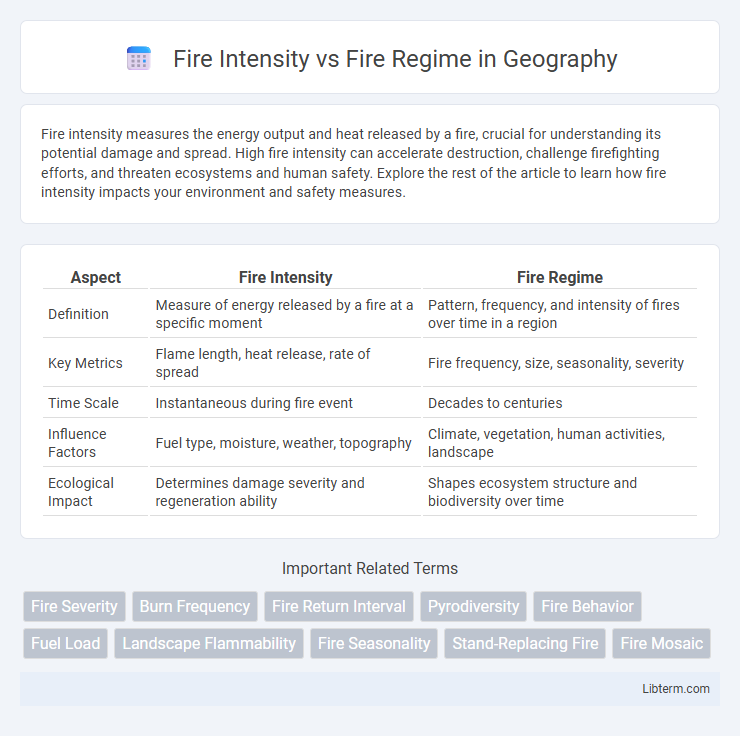Fire intensity measures the energy output and heat released by a fire, crucial for understanding its potential damage and spread. High fire intensity can accelerate destruction, challenge firefighting efforts, and threaten ecosystems and human safety. Explore the rest of the article to learn how fire intensity impacts your environment and safety measures.
Table of Comparison
| Aspect | Fire Intensity | Fire Regime |
|---|---|---|
| Definition | Measure of energy released by a fire at a specific moment | Pattern, frequency, and intensity of fires over time in a region |
| Key Metrics | Flame length, heat release, rate of spread | Fire frequency, size, seasonality, severity |
| Time Scale | Instantaneous during fire event | Decades to centuries |
| Influence Factors | Fuel type, moisture, weather, topography | Climate, vegetation, human activities, landscape |
| Ecological Impact | Determines damage severity and regeneration ability | Shapes ecosystem structure and biodiversity over time |
Understanding Fire Intensity: Definition and Metrics
Fire intensity measures the energy output during a wildfire, typically quantified in kilowatts per meter (kW/m) and representing the heat released per unit length of the fire front. Key metrics include flame length, rate of spread, and temperature, which collectively help assess the fire's potential to cause damage to vegetation and structures. Understanding these parameters is crucial for predicting fire behavior, managing fuel loads, and implementing effective firefighting strategies within specific fire regimes.
What is a Fire Regime? Key Characteristics
A fire regime describes the pattern, frequency, and intensity of fires that typically occur in a specific ecosystem over long periods. Key characteristics include fire interval, fire severity, seasonality, and spatial extent, which together influence vegetation structure and species composition. Understanding fire regimes helps in managing ecosystems and predicting ecological responses to changing fire intensities and frequencies.
Core Differences Between Fire Intensity and Fire Regime
Fire intensity refers to the energy output or heat released during a fire event, measured often in kilowatts per meter, indicating the immediate impact and potential damage on vegetation and structures. Fire regime encompasses the long-term patterns of fire occurrence, frequency, seasonality, and severity in a specific ecosystem, shaping vegetation dynamics and biodiversity over time. The core difference lies in fire intensity describing the magnitude of a single fire event, while fire regime represents the historical and ecological fire behavior trends within an area.
Factors Influencing Fire Intensity
Fire intensity is primarily influenced by fuel type and moisture content, weather conditions such as wind speed and temperature, and topography including slope steepness. Fire regimes describe the long-term patterns of fires in an area, encompassing frequency, size, and intensity, but intensity itself varies significantly with immediate environmental factors. Understanding the interplay of these elements helps in predicting fire behavior and managing wildfire risks effectively.
Historical Perspectives on Fire Regimes
Historical perspectives on fire regimes reveal patterns of fire frequency, intensity, and seasonality that shaped ecosystems over centuries. Fire intensity, defined by the energy released during a fire, influences vegetation structure and soil properties, while fire regimes encompass these variables alongside spatial extent and recurrence intervals. Understanding past fire regimes helps ecologists predict ecosystem responses to future climate changes and informs land management strategies aimed at maintaining biodiversity and reducing catastrophic wildfires.
Ecosystem Impacts: Intensity vs. Regime
Fire intensity, defined by the energy output during combustion, directly influences immediate ecosystem damage such as vegetation mortality and soil sterilization, whereas fire regime encompasses the frequency, seasonality, and size of fires shaping long-term ecological patterns. High-intensity fires often cause severe structural changes and nutrient volatilization, disrupting habitat complexity and altering species composition. Conversely, fire regimes maintain ecosystem resilience by supporting species adapted to specific fire return intervals, promoting biodiversity and nutrient cycling despite periodic biomass loss.
Fire Management Strategies: Intensity and Regime Considerations
Fire management strategies must balance fire intensity and fire regime to effectively reduce ecological damage and promote ecosystem resilience. Understanding the historical fire regime, including frequency, seasonality, and intensity, allows for tailored prescribed burns that mimic natural conditions and control fuel loads. Incorporating fire intensity data helps optimize suppression tactics and allocate resources to minimize high-severity fire spread while supporting long-term landscape health.
Fire Intensity’s Role in Shaping Vegetation Patterns
Fire intensity significantly influences vegetation patterns by determining plant survival, regeneration, and species composition within fire-prone ecosystems. High-intensity fires can eliminate mature trees and promote fire-adapted species, while low-intensity fires maintain understory diversity and reduce fuel load. Fire regimes, encompassing frequency, intensity, and seasonality, interact with fire intensity to shape long-term vegetation dynamics and ecosystem resilience.
Climate Change Effects on Fire Regimes and Intensity
Climate change significantly alters fire regimes by increasing temperatures and reducing precipitation, leading to longer fire seasons and more frequent wildfires. Elevated fire intensity results from drier fuels and higher wind speeds, intensifying fire behavior and severity. Shifts in fire regimes disrupt ecosystems, increasing the likelihood of large, high-intensity fires that challenge forest management and biodiversity conservation.
Future Challenges: Balancing Fire Intensity and Regime in Land Management
Future challenges in balancing fire intensity and fire regime in land management involve adapting strategies to increasingly erratic climate patterns and fuel loads. Effective management requires integrating predictive modeling of fire behavior with ecological restoration techniques to sustain biodiversity and reduce catastrophic wildfire risks. Emphasizing controlled burns and landscape heterogeneity can mitigate intense fires while preserving natural fire cycles critical for ecosystem health.
Fire Intensity Infographic

 libterm.com
libterm.com